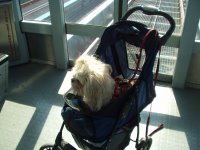
The Sackler Museum at Harvard is utterly amazing. Life size, sandstone wall carvings from Longmen caves. Wall paintings from Dunhuang, collected during the first Chinese Expedition in 1923. Perfect. Impeccable. Not a flaw, not an imperfection. How did they do it? How did they manage carve out a huge block of vertical (and crumbly, I should think) sandstone and transport it halfway around the world, back then? One can’t help wondering how many of them they spoiled, in order to get a few that were intact.
And the Shang bronzes. Omigod, the bronzes. I’ve seen photographs, of course. Hundreds of photographs, maybe thousands. The rhinoceros, for example. I think that’s one of the first Chinese bronze images I ever saw, in an art book. But I never realized it had teeth, two wonderful, perfect rows of teeth. You have to see these things in person, if you love them. And I do love them.
There were jades, wonderful jades, things I’ve never seen anyplace else. An intricate, jade garment hinge, as long as my finger, for instance. Can you imagine a hinge, carved out of jade, which is one of the hardest stones in the world? Actually, you don’t carve it. You abrade it, with sand, very, very slowly. Imagine the work that went into this single garment hinge. Is there anyone alive today who could duplicate this piece, with all our technology? I doubt it.
There were turquoise inlaid ceremonial axes and daggers, 3000 years old. There was a set of tiny jade animals, some of which resembled the carvings of the Olmec, in South America. Many of the Shang motifs are identical to those of the Olmec, but I’ve never seen actual, carved animals from China dating from this period before.
This is absolutely the best collection of ancient Chinese artefacts I’ve ever seen anywhere, including the Shanghai Museum.
And the ink scrolls … but I think you’re beginning to get the picture, and I don’t want to bore you. Bao got bored. Once he’d rolled on the floor, he was ready to move on.
We were about to head off to Connecticut (which turned out to be a much longer drive than I thought) so there wasn’t much time. Moreover, Barbara had experienced a “senior moment” in Salem, and I wasn’t sure she going to be able to cope with Cambridge’s tangled spaghetti of streets. We almost didn't go. But in the end, I couldn’t leave Boston without seeing the Sackler, or at least, trying to see it. There was no place to park, of course. There never is, in Boston. They pride themselves on it. But I drove round and round and we finally did find a place half a mile away, and then we walked. (I walked. Bao rode in the stroller. That stroller has been a Godsend)
There are other things in the Sackler, equally wonderful. (And other museums in the complex, including the Fogg) We only had time for the Roman artefacts (including a complete, intricately carved marble sarcophagus) and the Greek section. Here’s Bao, trying to figure out why anyone would write an ode about a Grecian urn.
On to Connecticut, and a very special art exhibition.




















